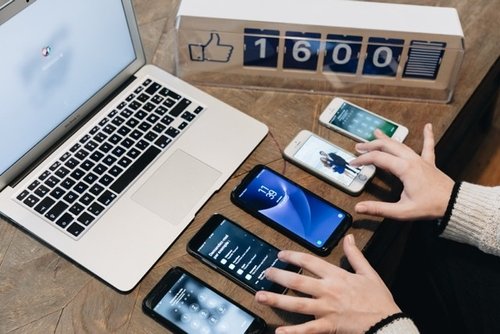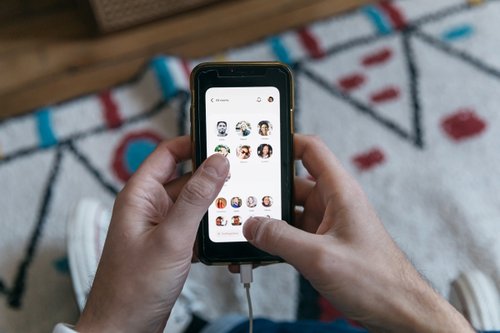How real can we be on LinkedIn?
Dec 10, 2020 - updated Mar 27, 2024
6 mins


Journalist
Forget perfectly curated Instagram accounts, keeping it real is having a moment on social media. Over on LinkedIn, users are also slowly beginning to question the ultra-rosy picture of our work lives painted by influencers. After all, everyone’s career has its ups and downs. But can we be authentic on a professional networking platform in the same way?
LinkedIn was founded in 2003 and has since grown to become the largest online professional network, with more than 1 billion registered users in 200 countries. But of 310 million active LinkedIn users, only around 1% create and share content. SEO specialist and copywriter Darina Linkova is used to seeing her words published online and posts regularly on Instagram, but she shies away from LinkedIn. “LinkedIn feels far more serious to me,” she said. “Since I joined several years ago, I have posted only twice and it didn’t feel right.”
Posting on LinkedIn ‘feels like boasting’
Linkova puts her discomfort down to the endless success stories on the platform. “Nearly all of the posts on my feed are from company owners who boast about their success and do so regularly. Earlier this year, I decided to share finishing the Google Analytics advanced online course and I immediately regretted it. It felt like I was boasting,” she said.
Alex Willen, the founder of dog treats company Cooper’s Treats, agrees. “Posting on LinkedIn just feels so shamelessly self-promotional, as if everything anyone posts on there is purely designed to advance their career. When I see people congratulating others it just feels like someone keeping a professional connection warm in case they need to ask them for a favor down the line.” He prefers posting pictures of his dogs on Instagram because it feels more authentic. “I love dogs,” he said. “And I genuinely believe that people want to see cute videos of mine.”
The state of LinkedIn
In 2011, a study by The New York Times found that the fundamental motivators for sharing content on any social network are “all about relationships”. Some 94% of respondents wanted to share information that would be useful for others, 84% to support causes that are close to them and 78% shared content to help them keep in touch with people.
In 2020, this continues to be relevant as complaints about LinkedIn focus on ways in which the platform rubs against these needs. Users feel pressure to post content that will improve their career prospects, and are worried that others will judge their posts, or that they cannot communicate their message authentically. When writer Noemi McElearney tries to post on LinkedIn, she simply says: “I feel like I can’t be myself.”
Then there’s the inauthentic content that thrives on the platform. Much has been written about a uniquely awful type of LinkedIn post dubbed broetry and there are entire Twitter profiles dedicated to poking fun at the platform’s content. Chrissie Zavicar, CEO of Stack Brands and a LinkedIn expert, says authenticity is key. “Over the past three years, the BS meter on LinkedIn is extremely sensitive. People don’t want to be sold to, they just want to kind of engage and have a conversation,” she said.
When helping people boost their LinkedIn profiles, Zavicar follows two rules. First, content must be of use to others: it must “entertain, inform or inspire”. Second, “It really has to fit who the person is. That’s what really resonates with people.”
Getting real on LinkedIn
One authentic voice is virtual assistant Luke Manton. Two years ago, after a serious illness, Manton developed Tourette’s syndrome. His symptoms include verbal tics that mean he often says explicit things unintentionally. Before his illness, Manton was very self-assured, but that suddenly changed. “My confidence was at zero. I spent a long time trying to hide who I was, not going out, not talking to people,” he said. At the same time he was job hunting and under pressure to perform in interviews. “I had a shocking experience job hunting. Tourette’s and the corporate world didn’t seem to go together,” he said.
Manton decided to use his LinkedIn platform to rectify this. He started posting a video series, Ticced Off, in September 2020 about his experience with Tourette’s syndrome. While many of us worry about posting content that is reasonably innocuous, Manton’s tics are on full display. He begins his video by introducing himself, before unwittingly inviting everyone watching to “get your dicks out.”
“I was so nervous about posting it,” he said, adding that he didn’t post it on Facebook, fearing a “brutal” response. However, on LinkedIn the reaction has been largely supportive and Manton hopes it is a step towards changing attitudes towards Tourette’s. “People with Tourette’s syndrome are constantly told they won’t fit into the corporate world. LinkedIn is the digital version of the corporate world so I’m using it to make a space,” he said.
The response has been life-changing. “It has given me the confidence boost I needed to know I will be successful,” he said. “I’m not scared to talk to or be seen by people anymore. Added to that, the reach of the videos has been huge and I’ve had a lot of clients from them.”
The cost of engagement
For many, LinkedIn is a unique chance to grow a business and build a brand. A 2019 study of 3,000 successful LinkedIn blog posts found that the most popular have a title that is 40-49 characters long, eight images, no multimedia, and are either a “how to” or a listicle style post, whereas more recent statistics found that a video post is 20 times more likely to be shared. The pressure to craft the perfectly optimized post is real for growing businesses.
This is a point of tension for Rhonda D’Ambrosio, founder of Mental Health in Recruitment. “I’ve got no problem posting on LinkedIn, I’m more than happy to put myself out there. But my feed is just filled with professional social marketing posts and media posts. And I just want to be myself,” she said. D’Ambrosio’s mission on the platform is to open up discussions about mental health, which brings a dilemma: crafting content and responding to every comment would spread her message, but at the expense of her mental well-being, as she already has a full-time job. “I wouldn’t finish work until 10 o’clock. I would stress myself out, and I would cause myself burnout,” she said.
However, hiring someone to write posts on her behalf feels “disingenuous”. “Because I’m talking about mental health and wellbeing, I feel like I’ve got a duty of care to represent myself in the most authentic way possible,” she said.
Is it time we brought our ‘whole selves’ to LinkedIn?
D’Ambrosio’s gut instinct may be right. A 2019 study by Stackla found that authenticity is important for 90% of social media users when deciding which brands to support yet 51% perceive that less than half of brands create authentic content. At the same time, social networks are a construction—to an extent, everything posted online is a performance.
Alexander Leon is a LinkedIn Changemaker, one of seven advocates partnering with the platform in the UK to “spark conversations” on LinkedIn. He thinks the tensions regarding authenticity on the platform reflect issues already at play in the physical workplace, which have shifted dramatically in past years. “Particularly now that so many people are working from home, the world of work and the world of our personal lives is going to blur,” he said. “We should feel more comfortable sharing parts of our personal lives on LinkedIn. Why is professionalism not sharing anything that’s going on in your real life? Why is professionalism not talking about your feelings?”
“Being real for me, means not censoring myself when I feel like I want to share something on LinkedIn that’s related to my work, and not stop myself from expressing how I’m feeling about something because I’m worried that it might affect the way people see me.” For Leon, a central part of being real on LinkedIn is talking about LGBTQ+ issues and anti-racism.
This comes with a caveat. “How real are we on any of our social media platforms?” he asks. However, being openly gay and part of the LGBTQ+ community on LinkedIn also gives Leon control over how he is received as a minority at work.
Instead of being outed by accident when a colleague unwittingly asks about his girlfriend or similar, “I get to do it on my terms,” he says. “When I talk about being gay on LinkedIn, I know that there are people who think that’s not relevant, and why is he talking about that? But for me, it gives me control over that conversation. I get to say this is who I am. I’m proud of who I am.”
Where to begin?
Where should someone who wants to share more on LinkedIn start? “Take small steps,” said Zavicar. “Don’t feel like you have to be somebody else. If something is not within your values, if it’s not what you truly feel comfortable doing, don’t do it. Just do things that are a little outside your comfort zone.”
Zavicar’s advice is to keep trying—and experiment. “You can put stuff out there and see if it sinks or swims immediately,” she said. “It’s really fun to be on that platform right now, and you have a once-in-a-lifetime opportunity to take it where it is at this exact moment. It’s never going to be the same, it continues to evolve at this rapid pace. So if you’re not already on, jump in.”
Whether you’re an almost-never poster, a self-promoter, or even a broetry writer, why not try to rethink your style next time you share a post with your professional network? Upping your authenticity on LinkedIn might spark more interest—and bring more opportunities—than you think.
Photo: Welcome to the Jungle
Follow Welcome to the Jungle on Facebook, LinkedIn, and Instagram, and subscribe to our newsletter to get our latest articles every day!

More inspiration: Build your network

Networking with social anxiety: 5 workers share their tips for dealing with it
For those with social anxiety, networking can feel impossible. See tips from real workers on how to step outside your comfort zone.
Feb 19, 2024

Should I share my life on social media? Our personal branding expert weighs in
In our Insta-globalized age, broadcasting your life online can land you a dream job — or land you in trouble...
Sep 07, 2023

How to get on the radar of people you admire
If you get yourself noticed by the right people and make a good impression, there’s a chance they will think of you when an opportunity opens up...
Mar 10, 2022

Inside Clubhouse: the invite-only app changing the way we network
This invite-only networking app has social media buzzing. So how does it work- and how can it help your career?
Mar 24, 2021

Online networking: a life-saver for introverts
If interacting with people you don't know is not one of your strengths, you may find the idea of building your network daunting.
Oct 13, 2020
The newsletter that does the job
Want to keep up with the latest articles? Twice a week you can receive stories, jobs, and tips in your inbox.

Looking for your next job?
Over 200,000 people have found a job with Welcome to the Jungle.
Explore jobs